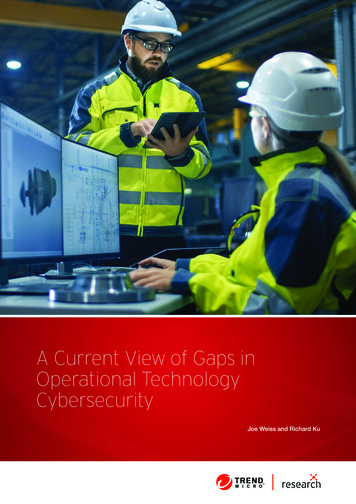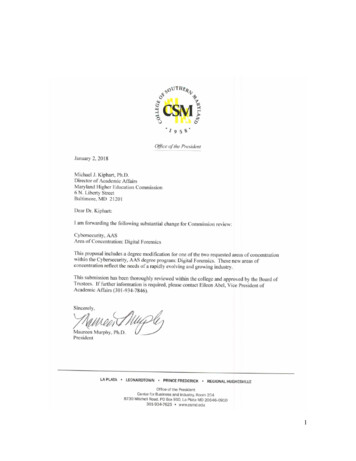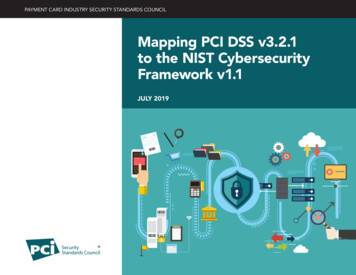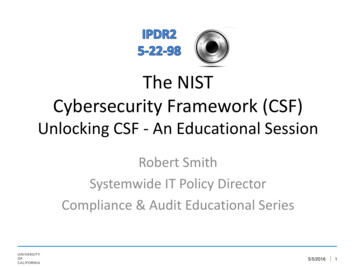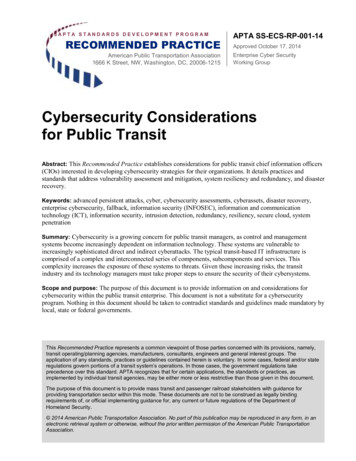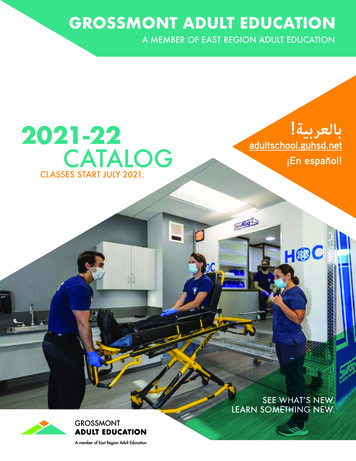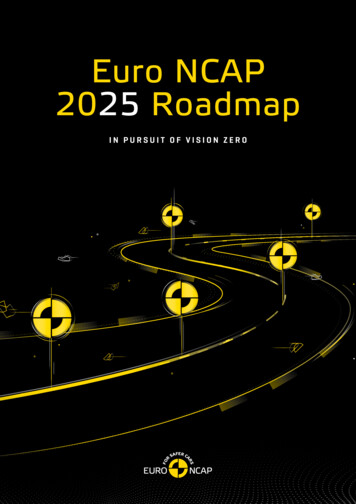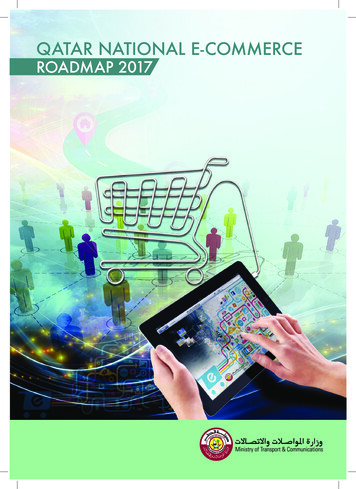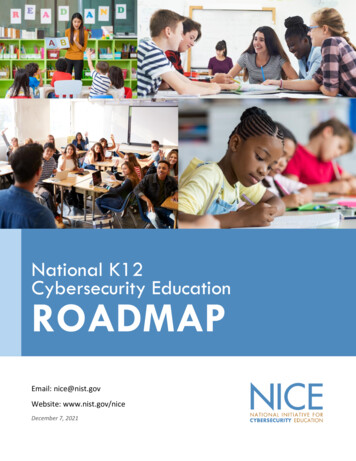
Transcription
National K12Cybersecurity EducationROADMAPEmail: nice@nist.govWebsite: www.nist.gov/niceDecember 7, 2021
2TABLE OF CONTENTSIntroduction . 31. Increase Cybersecurity Career Awareness . 42. Engage Students Where Disciplines Converge . 43. Stimulate Innovative Educational Approaches. 54. Promote Cybersecurity Career Pathways . 55. Prioritize Research . 6
3IntroductionThe National K12 Cybersecurity Education ROADMAP establishes a coordinated, coherent portfolio ofNational K12 Cybersecurity Education activities so that efforts and assets are deployed effectively andefficiently for greatest potential impact. The intent is to encourage a more deliberate focus among newand existing efforts and create synergies among programs and government agencies.The five major elements and accompanying strategies of the National K12 Cybersecurity EducationROADMAP align to the 2021-2025 National Initiative for Cybersecurity Education (NICE) Strategic Planwhich was released in November 2020. The development and maintenance of the National K12Cybersecurity Education Roadmap will support and guide the community on K12 cybersecurityeducation, and sharing these strategies will increase the quantity, quality, and diversity of studentspursuing cybersecurity careers.
41. Increase Cybersecurity Career AwarenessGrow and sustain youth and public engagement in promoting cybersecuritycareer awareness and exploration1.1 Communicate the value and purpose of a national K12 cybersecurity education strategy (i.e.,the K12 Cybersecurity Education Roadmap) and the need for engagement1.2 Expand public awareness and engagement of the cybersecurity career awareness campaigntargeting educators, students, parents, counselors, and others that influence career choices1.3 Support effective co-curricular experiences (e.g., competitions, camps, clubs, informalexperiences, etc.) for youth that excites them about careers in cybersecurity and introducesthem to multiple corresponding career pathways1.4 Improve the appeal and understanding of the cybersecurity work roles identified in theWorkforce Framework for Cybersecurity (NICE Framework)1.5 Promote participation of underserved groups in cybersecurity activities and educationprograms to support diversity, equity, inclusion, and accessibility1.6 Identify and disseminate successful methods and metrics for building cybersecurity careerawareness2. Engage Students Where Disciplines ConvergeIdentify, design, and share cybersecurity resources for the future STEM andcybersecurity workforce2.1 Engage students where disciplines converge using cybersecurity as an interwoven andcomplex pursuit that blends disciplines and industry sectors and makes STEM andcybersecurity learning meaningful and inspiring2.2 Assist in building computational literacy by infusing cybersecurity concepts aligned to theNICE Framework into the learning process focusing on the holistic convergence1 ofeducational disciplines2.3 Determine and share proven methods and metrics for recognizing successful and meaningfulprograms and content2.4 Develop and replicate successful content and programs that support youth obtainingcybersecurity credentials (e.g., diplomas, degrees, certificates, certifications, badges) thatassess learners’ cybersecurity competencies using evidence-based practices and assessmentsthat can be emulated by other stakeholders1The National Science Foundation defines convergence as the deep integration of knowledge, techniques, and expertise from multiple fields to form newand expanded solutions for addressing scientific and societal challenges and opportunities. Convergence refers to not only the convergence of expertiseacross disciplines but also the convergence of academic, government, and industry stakeholders to support scientific investigations and enable rapidtranslation of the resulting advances. Convergence integrates knowledge, tools, and ways of thinking from multiple disciplines to form a comprehensivemeans to tackling scientific and societal challenges that exist at the interfaces of multiple fields. The Federal Coordination in Science, Technology,Engineering, and Mathematics Education (FC-STEM) Convergence Interagency Working Group recognizes that new global problems cannot be solved bylooking at them through a single lens or a particular mindset. Instead, experts from different disciplines must work together and blend their knowledge,theories, expertise, methods, data, and research to create coherence and comprehensive solutions. This needs to be modeled at every level of educationand research and should be incorporated in K-20 learning.
53. Stimulate Innovative Educational ApproachesEnrich K12 cybersecurity education instruction and learning3.1 Enhance coordination among teacher preparation, professional development, support, andrecognition efforts within instructional training options and existing and proposedcybersecurity educator programs3.2 Stimulate innovative and effective educational approaches to accelerate learning and skillsdevelopment leveraging work done in other domains3.3 Improve the quality of cybersecurity instruction and learning by advocating forimplementation of proven pedagogical practices and supporting innovative and evidencebased instructional strategies (e.g., differentiated instruction, game-based learning, blendedlearning, team science learning, expeditionary learning, simulations, hands-on activities)3.4 Promote increasing the number of educators who can effectively promote cybersecuritycareers and prepare youth for obtaining cybersecurity or cybersecurity-related credentials3.5 Recognize and publicize proven methods and metrics for recognizing proven pedagogicalpractices and evidence-based learning methods and experiences3.6 Develop communities of practice that enable educators and community members to discussbest practices, challenges, opportunities, and implement instructional changes4. Promote Cybersecurity Career Pathways2Cultivate youth pursuing cybersecurity or cybersecurity-related credentials (e.g.,diplomas, degrees, certificates, certifications, badges)4.1 Inspire, cultivate, and develop exceptional cybersecurity talent through a continuum ofopportunities to enrich our current and future cybersecurity workforce4.2 Support and promote cybersecurity career preparedness for students through a variety oflearning pathways (e.g., Career Technical Education-CTE, Programs of Study-POS, youthapprenticeship, pre-apprenticeship, PTECH, early college programs, and other “alternative”opportunities)4.3 Encourage schools to provide dual enrollment, early college programs, and other creativeefforts that challenge students academically and provide opportunities to reduce the timeand cost of obtaining a cybersecurity or cybersecurity-related credential4.4 Promote youth work-based learning experiences (e.g., internships, externships, jobshadowing, apprenticeships)4.5 Identify and share proven methods and metrics for recognizing successful cybersecuritycareer preparedness opportunitiesWorkforce Innovation and Opportunity Act (WIOA) defines a career pathway as “a combination of rigorous and high-quality education, training, andother services that: (A) aligns with the skill needs of industries in the economy of the State or regional economy involved; (B) prepares an individual to besuccessful in any of a full range of secondary or postsecondary education options, including registered apprenticeships; (C) i ncludes counseling to supportan individual in achieving the individual’s education and career goals; (D) includes, as appropriate, education offered concurrently with and in the samecontext as workforce preparation activities and training for a specific occupation or occupational cluster; (E) organizes education, training, and otherservices to meet the particular needs of an individual in a manner that accelerates the educational and career advancement of the individual to the extentpracticable; (F) enables an individual to attain a secondary school diploma or its recognized equivalent, and at least one recognized postsecondarycredential; and (G) helps an individual enter or advance within a specific occupation or occupational cluster.” [Section 3(7) of WIOA] for additionalinformation see PCRN: Career Pathways Systems (ed.gov) and Building Career Pathways Programs & Systems: Insights from TAACCCT (dol.gov).2
65. Prioritize ResearchEnhance efficiency and effectiveness of K12 cybersecurity education programsand instructional practices5.1 Develop a systematic approach to identify and share content and instructional best practicesin educational and engagement environments5.2 Advance K12 cybersecurity programs by sharing educational and engagement environmentsbased on evidence using a systematic approach5.3 Curate and communicate K12 cybersecurity career awareness and preparedness research5.4 Generate a results-oriented annual report to guide K12 cybersecurity education process andprogressNext StepsThe NICE K12 Community of Interest and other members of the NICE Community Coordinating Councilare continually developing actions for the strategies identified for each of the five elements of theROADMAP that align to the NICE Strategic Plan. Further, the K12 Community of Interest continues toidentify indicators of success for each action. The K12 Community of Interest maintains anenvironmental scan of existing programs, resources, and activities and encourages other communitymembers to add to the “evergreen” environmental tracker resource. The K12 Community of Interestwill also establish project teams, as necessary, to pursue actions, many in coordination with other NICEWorking Groups. To learn more about the NICE Community Coordinating Council, NICE K12 Communityof Interest, and current project teams or to get involved, visit www.nist.gov/nice/community.
Dec 07, 2021 · the K12 Cybersecurity Education Roadmap) and the need for engagement . Workforce Framework for Cybersecurity (NICE Framework) . 1 The National Science Foundation defines convergence as the deep integration of knowledge, t

